Biology:List of butterflies of India (Papilionidae)

Blue Mormon (Papilio polymnestor), common Mormon (Papilio polytes) and common bluebottle (Graphium sarpedon). (left to right anticlockwise)



This is a list of the butterflies of family Papilionidae (superfamily Papilionoidea), or the swallowtails, which are found in India . This family of large and beautiful butterflies is well represented with 89 species found within Indian borders.[1] Two of the three papilionid subfamilies are represented in India, namely, the Parnassiinae or Apollos, with 19 species, and the Papilioninae or swallowtails, with 70 species.
The area of India falls in the Indomalayan realm, except for the Himalayas above and beyond the foothills adjoining the Indo-Gangetic Plains, and which fall in the Palearctic realm,[2] resulting in increased diversity of papilionid butterflies, especially the Parnassiini or snow Apollos, all species of which are Palearctic.
Indian swallowtails are spread over all the biomes/ecoregions of India. The Malabar banded peacock (Papilio buddha) and the Malabar banded swallowtail (Papilio liomedon) fly at sea level while the Apollos (Parnassius species), are to be found only in the highest alpine meadows of the Himalayas. Some species such as the common Mormon (Papilio polytes) and the blue Mormon (Papilio polymnestor) fly at ground level whereas others, such as the tailed jay (Graphium agamemnon) are normally found flying high in the forest canopy. The lime butterfly (Papilio demoleus) is a creature of arid scrub-land, occasionally being spotted even in the Thar Desert, while the tropical evergreen forests have their own representatives, such as the red Helen (Papilio helenus), the common bluebottle (Graphium cloanthus) and the Malabar raven (Papilio dravidarum).[3] Indian papilionids such as the common Mormon (Papilio polytes) and great Mormon (Papilio memnon) show polymorphism with many mimetic female forms.[4][5]
Amongst swallowtails, endemism is found only in the Western Ghats. Notable endemics are the southern birdwing (Troides minos), Malabar banded swallowtail (Papilio liomedon), Malabar raven (Papilio dravidarum), Malabar rose (Pachliopta pandiyana) and the Malabar banded peacock (Papilio buddha).[6]
This list is based on A Synoptic Catalogue of the Butterflies of India by R. K. Varshney and Peter Smetacek (2015).[7]
Subfamily Papilioninae
The swallowtails are generally easily identified in the field by their large size, prominent markings, colour, patterns and variable wing and tail shape.
Tribe Troidini
Troides Huebner, [1819] – birdwings
The birdwings, as the Troides butterflies are called are large, yellow-and-black coloured butterflies, two species of which are found in the forests of the Himalayas and one species in the Western Ghats. These are the largest butterflies found in India.
- Common birdwing, Troides helena (Linnaeus, 1758)
- Southern birdwing, Troides minos (Cramer, [1779])
- Golden birdwing, Troides aeacus (C. Felder & R. Felder, 1860)
-
Common birdwing
-
Southern birdwing
-
Golden birdwing
- Red-bodied swallowtails
The genera Losaria, Pachliopta and Byasa of the Indian Troidini are commonly called as the red-bodied swallowtails along with the Atrophaneura. They were formerly considered to be subgenera under genus Atrophaneura till several authorities elevated them to genus level in their publications (e.g. LepIndex; GLoBIS; Racheli & Cotton (2010)).[8][9][10][11] These butterflies sequester toxins from plants and are inedible or poisonous to predators. They also have warning colouration, a phenomenon also known as aposematism. The red-bodied swallowtails are involved in Batesian mimicry complexes as aposematic models which are mimicked by edible species.
Atrophaneura Reakirt, [1865] – batwings
Red-bodied swallowtails with black wings hat are found in low elevation forests along the Himalayas and the Northeast of India.
- Lesser batwing, Atrophaneura aidoneus (Doubleday, 1845)
- Common batwing, Atrophaneura varuna (A. White, 1842)[12]
-
Lesser batwing
-
Common batwing
Byasa Moore, 1882 – windmills
Black-coloured red-bodied swallowtails with elongated wings, prominent white and red spots, and tails that are found in low elevation forests along the Himalayas and the Northeast of India.
- Common windmill, Byasa polyeuctes (Doubleday, 1842)
- Rose windmill, Byasa latreillei (Donovan, 1826)
- Neville's windmill, Byasa nevilli (Wood-Mason, 1882)
- De Nicéville's windmill, Byasa polla (de Nicéville, 1897)
-
Common windmill
-
Rose windmill
-
Neville's windmill
-
De Nicéville's windmill
- Great windmill, Byasa dasarada (Moore, 1858)
- Black windmill, Byasa crassipes (Oberthür, 1893)
- Chinese windmill, Byasa plutonius (Oberthür, 1876)
-
Great windmill
-
Black windmill
-
Pemberton's windmill
Losaria Moore, 1902 – clubtails
Red-bodied swallowtails with club-shaped tails that are found in low elevation forests along the Himalayas and the Northeast of India.
- Common clubtail, earlier Losaria coon (Fabricius, 1793) now Losaria doubledayi (Wallace, 1885)[13]
- Andaman clubtail, Losaria rhodifer (Butler, 1876)
-
Common clubtail
-
Andaman clubtail
Pachliopta Reakirt, [1865] – roses
Red-bodied swallowtails commonly found all over India (except for the endemic Malabar rose), which serve as aposematic models for Papilio polytes in Batesian mimicry complex.
- Common rose, Pachliopta aristolochiae (Fabricius, 1775)
- Crimson rose, Pachliopta hector (Linnaeus, 1758)
- Malabar rose, Pachliopta pandiyana (Moore, 1881)
-
Common rose
-
Crimson rose
-
Malabar rose
Tribe Papilionini
Papilio Linnaeus, 1758 – swallowtails
Black-bodied swallowtails, often distinctively marked, some widely distributed, which are edible and form Batesian mimicry complexes with danaines or red-bodied swallowtails. Some species are polymorphic, mostly in the female forms.
Papilio (Chilasa) – mimes
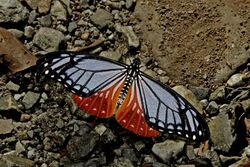
Medium-sized tailless swallowtail butterflies which mimic the milkweed butterflies, which they fly alongside, both in appearance and methods of flight. Except for the Common Mime which is also found in peninsular India, they are confined to the lower Himalayas and Northeast India.
- Tawny mime, Papilio agestor Gray, 1831
- Lesser mime, Papilio epycides Hewitson, 1864
- Blue striped mime, Papilio slateri Hewitson, 1859
- Great blue mime, Papilio paradoxa (Zinken, 1831)
- Common mime, Papilio clytia, Linnaeus, 1758
-
Lesser mime(Papilio epycides)
-
Blue striped mime(Papilio slateri)
-
Great blue mime(Papilio paradoxus)
-
Common mime(Papilio clytia)
Papilio (Papilio) – yellow swallowtails

- species group machaon
- Common yellow swallowtail, Papilio machaon Linnaeus, 1758
Papilio (Princeps) – Mormons, Helens, ravens
- species group demodocus
- Lime butterfly, Papilio demoleus Linnaeus, 1758
- species group demolion
- Malabar banded swallowtail, Papilio liomedon Moore, 1875
- species group polytes
- Common Mormon, Papilio polytes Linnaeus, 1758
-
Lime butterfly
-
Malabar banded swallowtail
-
Common Mormon
- species group helenus
- Large, tailed, black butterflies with prominent yellow patch on upper hindwing markings, which occur along the low elevation forests of the Himalayas, the Western Ghats and some peninsular Indian forests.
- Red Helen, Papilio helenus Linnaeus, 1758
- Yellow Helen, Papilio nephelus Boisduval, 1836
- Andaman Helen, Papilio prexaspes C. Felder & R. Felder, 1865
- Large, tailed, black butterflies with prominent yellow patch on upper hindwing markings, which occur along the low elevation forests of the Himalayas, the Western Ghats and some peninsular Indian forests.
-
Red Helen
-
Yellow Helen
-
Andaman Helen
- species group memnon
- Large, tailless, black butterflies with blue and white markings, which occur along the low elevation forests of the Himalayas, the Western Ghats and some peninsular Indian forests. Despite the name, only the great Mormon is polymorphic.
- Great Mormon, Papilio memnon Linnaeus, 1758
- Blue Mormon, Papilio polymnestor Cramer, [1775]
- Andaman Mormon, Papilio mayo Atkinson, [1874]
- Large, tailless, black butterflies with blue and white markings, which occur along the low elevation forests of the Himalayas, the Western Ghats and some peninsular Indian forests. Despite the name, only the great Mormon is polymorphic.
-
Great Mormon
-
Blue Mormon
-
Anadaman Mormon
- species group protenor
- Large tailless swallowtails which are black above with no white marking and which do not have basal red markings below. Found in Himayas and Northeast India in low elevation jungles.
- Spangle, Papilio protenor Cramer, [1775]
- Redbreast, Papilio alcmenor C. Felder & R. Felder, [1864]
- Large tailless swallowtails which are black above with no white marking and which do not have basal red markings below. Found in Himayas and Northeast India in low elevation jungles.
-
Spangle
-
Redbreast
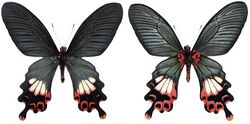
- species group bootes
- Tailed redbreast, Papilio bootes Westwood, 1842
- species group castor
- Tailless black or blackish-brown butterflies with white markings, the females or both sexes of which mimic inedible milkweed butterflies.
- Common raven, Papilio castor Westwood, 1842
- Malabar raven, Papilio dravidarum Wood-Mason, 1880
- Tailless black or blackish-brown butterflies with white markings, the females or both sexes of which mimic inedible milkweed butterflies.
-
Common raven
-
Malabar raven
Papilio (Achillides) – peacocks

Large strong-flying black butterflies with distinctive colourful markings, most species of which occur along the low elevation forests of the Himalayas while a few species occur in the Western Ghats and some peninsular Indian forests.
- species group paris
- Blue peacock, Papilio arcturus Westwood, 1842
- Common peacock, Papilio bianor Cramer, [1777]
- Yellow-crested spangle, Papilio elephenor Doubleday, 1845
- Paris peacock, Papilio paris Linnaeus, 1758
- Krishna peacock, Papilio krishna Moore, 1858
-
Blue peacock
-
Common peacock
-
Yellow-crested spangle
-
Krishna peacock
- species group: palinurus
- Common banded peacock, Papilio crino Fabricius, 1793
- Malabar banded peacock, Papilio buddha Westwood, 1872
-
Common banded peacock
-
Malabar banded peacock

Papilio (Sinoprinceps) – Chinese swallowtails
- species group: xuthus
- Chinese yellow swallowtail, Papilio xuthus Linnaeus, 1767
Tribe Leptocircini
Graphium Scopoli, 1777 – bluebottles, jays, swordtails and zebras
Graphium (Graphium) – bluebottles and jays
- Common bluebottle, Graphium sarpedon (Linnaeus, 1758)
- Glassy bluebottle, Graphium cloanthus (Westwood, 1841)
- Common jay, Graphium doson (C. Felder & R. Felder, 1864)
- Tailed jay, Graphium agamemnon (Linnaeus, 1758)
-
Common bluebottle
-
Glassy bluebottle
-
Common jay
-
Tailed jay
- Spotted jay, Graphium arycles (Boisduval, 1836)
- Veined jay, Graphium chironides (Honrath, 1884)
- Great jay, Graphium eurypylus (Linnaeus, 1758)
- Scarce jay, Graphium albociliates (Fruhstorfer, 1901)
-
Spotted jay
-
Veined jay(Graphium chiron)
-
Great jay
Graphium (Paranticopsis) – zebras
The zebras are tailless swallowtails found in the Himalayas and Northeast that mimic the aposematic bluish-white Danaus milkweed butterflies.
- Great zebra, Graphium xenocles (Doubleday, 1842)
- Lesser zebra, Graphium macareus (Godart, 1819)
- Spotted zebra, Graphium megarus (Westwood, 1844)
-
Great zebra(Graphium xenocles)
-
Lesser zebra(Graphium macareus)
-
Spotted zebra(Graphium megarus)
- Swordtails
These butterflies, formerly Graphium, are now divided into two genera Pathysa and Pazala. They are large white butterflies with black bars in the cells of the forewings, and the hindwings each bearing a long sword-like tail. They are butterflies of hilly forests from the Himalayas to the Northeast, except for the fivebar swordtail which also flies in the Western Ghats and the spot swordtail which is also found in peninsular India and the Indo-Gangetic plains.
Graphium (Pathysa) – swordtails
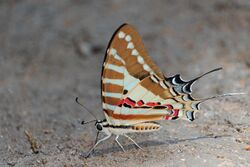
- Fourbar swordtail, Graphium agetes (Westwood, 1843)
- Fivebar swordtail, Graphium antiphates (Cramer, [1775])
- Chain swordtail, Graphium aristeus (Stoll, [1780])
- Andaman swordtail, Graphium epaminondas (Oberthür, 1879)
- Spot swordtail, Graphium nomius (Esper, 1799)
-
Fourbar swordtail(Graphium agetes)
-
Fivebar swordtail
-
Chain swordtail
-
Andaman swordtail(Graphium epaminondas)
Graphium (Pazala) – swordtails
- Sixbar swordtail, Graphium eurous (Leech, [1893])
- Spectacle swordtail, Graphium mandarinus (Oberthür, 1879)
-
Sixbar swordtailGraphium eurous
-
Spectacle swordtailGraphium mandarinus
Lamproptera Gray, 1832 – dragontails
Lamproptera or dragontails, are small swallowtail butterflies with large tails found in the tropical and subtropical forests of Northeast India, and further East.
- Green dragontail, Lamproptera meges (Zinken, 1831)
- White dragontail, Lamproptera curius (Fabricius, 1787)
-
Green dragontail (Lamproptera meges)
-
White dragontail (Lamproptera curius)
Tribe Teinopalpini
Teinopalpus Hope, 1843 – Kaiser-e-Hind

The Kaiser-i-Hind is a rare species of swallowtail butterfly found from Nepal and north India eastwards to north Vietnam. The common name literally means "Emperor of India", and it is much sought after by butterfly collectors for its beauty and rarity.
- Kaiser-e-Hind, Teinopalpus imperialis Hope, 1843
Meandrusa Moore, 1888 – hooked swallowtails
Large sombre-coloured swallowtails with triangular forewings with concave outer margins, sinuously margined hindwing and long outwardly-curved spatulate tail. Found in low elevation forests along the central and eastern Himalayas and the Northeast.
- Brown gorgon, Meandrusa lachinus (Fruhstorfer, 1902)
- Yellow gorgon, Meandrusa payeni (Boisduval, 1836)
-
Brown gorgon(Meandrusa lachinus)
-
Yellow gorgon
Subfamily Parnassiinae
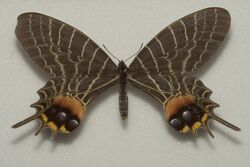
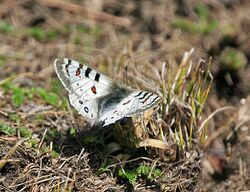

The Parnassiinae include about 50 medium-sized, white or yellow high-altitude butterflies that are distributed across Asia, Europe and North America, of which 19 species fly in India.
Tribe Zerynthiini
Bhutanitis Atkinson, 1873 – Bhutan glory
The genus Bhutanitis contains large butterflies that are black with thin white stripes above, have red and yellow tornal patches on the hindwing, and a number of tails, which are found in the region of Bhutan, Northeast India, Myanmar, Thailand and South China.
- Bhutan glory, Bhutanitis lidderdalii Atkinson, 1873
- Ludlow's Bhutan glory, Bhutanitis ludlowi Gabriel, 1942[14]
Tribe Parnassiini
Parnassius Latreille, 1804 – Apollos
The Apollos, genus Parnassius are high altitude palearctic butterflies that are different in appearance from other swallowtails, being of moderate size, with white ground colour, and spotted with red, black and blue.
- Subgenus Parnassius Latreille, 1804
- Scarce red Apollo, Parnassius actius (Eversmann, 1843)
- Common red Apollo, Parnassius epaphus Oberthür, 1879
- Keeled Apollo, Parnassius jacquemontii Boisduval, 1836
- Large keeled Apollo, Parnassius tianschianicus Oberthür, 1879
- Subgenus Kailasius Moore, 1902
- Regal Apollo, Parnassius charltonius Gray, [1853]
- Stately Apollo, Parnassius loxias Püngeler, 1901
- Noble Apollo, Parnassius augustus Fruhstorfer, 1903
- Dusky Apollo Parnassius acdestis Grum-Grshimailo, 1891
- Subgenus Koramius Moore, 1902
- Karakoram banded Apollo, Parnassius hunza Grum-Grshimailo, 1888
- Scarce banded Apollo Parnassius mamaeivi Bang-Haas, 1915
- Greater banded Apollo, Parnassius stenosemus Honrath, 1890
- Lesser banded Apollo, Parnassius stoliczkanus C. Felder & R. Felder, 1865
- Himalayan banded Apollo, Parnassius kumaonensis Riley, 1926
- Subgenus Tadumia Moore, 1902
- Varnished Apollo, Parnassius acco Gray, [1853]
- Royal Apollo, Parnassius maharaja Avinoff, 1916
- Subgenus Lingamius Bryk, 1935
- Common blue Apollo, Parnassius hardwickii Gray, 1831
- Subgenus Kreizbergia Korshunov, 1990
- Black-edged Apollo, Parnassius simo Gray, 1853
See also
- Papilionidae
- List of butterflies of India
Cited references
- ↑ Evans (1932) states, in a table on pg 23, the number of papilionids in the Indian subcontinent as 90; 15 species being found in Ceylon, 19 in South India, 6 in Baluchistan, 11 in Chitral, 31 in the western Himalayas, 69 in Northeast India, 50 in southern Myanmar and 13 in the Andaman and Nicobar islands. Wynter-Blyth (1957) gives a modified version of the same table on p. 12, where the overall number of species is 94; with differences being in total number of species for Northeast Himalayas (62) and Myanmar (66). The present list is based on the IUCN red data book, with corrections made by subsequent editors especially in the Parnassiinae. Kunte (2000) on p. 55 mentions a total of 107 species with 19 in peninsular India . Varshney & Smetacek (2015), which this article follows, lists 89 species.
- ↑ Udvardy, M.D.F. (1975). A classification of the biogeographical provinces of the world (Report). IUCN Occasional Paper. IUCN, Morges, Switzerland. pp. 20–24, 28–30. https://portals.iucn.org/library/efiles/documents/OP-018.pdf. Retrieved 10 May 2020.
- ↑ Kunte, Krushnamegh (2000). Butterflies of Peninsular India. India, A Lifescape. Hyderabad, India: Universities Press. pp. 55–58, chapter 5.1. ISBN 978-8173713545. https://books.google.com/books?id=cuPPjOMcu_4C.
- ↑ Clarke, C. A.; Sheppard, P. M. & Thornton, I. W. B. "The Genetics of the Mimetic Butterfly Papilio memnon L." Philosophical Transactions of the Royal Society, London. (B – Biological Sciences) 22 August 1968 vol. 254 no. 791 37–89. Abstract. Retrieved 20 January 2010.
- ↑ Clarke, C. A. & Sheppard, P. M. "The Genetics of the Mimetic Butterfly Papilio polytes L." Philosophical Transactions of the Royal Society, London. (Series B, Biological Sciences) Vol. 263, No. 855 (16 March 1972), pp. 431–458. Abstract. Retrieved 20 January 2010.
- ↑ Kehimkar, Isaac (2009). The Book of Indian Butterflies. Mumbai: Bombay Natural History Society. p. 38; 497. ISBN 978-0-19-569620-2. https://books.google.com/books?id=zFy8NwAACAAJ. Retrieved 21 October 2010.
- ↑ Varshney, R.K.; Smetacek, Peter (2015). A Synoptic Catalogue of the Butterflies of India. Butterfly Research Centre, Bhimtal & Indinov Publishing, New Delhi. https://www.researchgate.net/publication/287980260. Retrieved 20 April 2020.
- ↑ Fernando, E.; Jangid, A.K.; Kehimkar, I.; Lo, P.; Moonen, J. (2019). Byasa crassipes (Report). The IUCN Red List ofThreatened Species 2019. IUCN. doi:10.2305/IUCN.UK.2019-3.RLTS.T121971897A122602141.en.
- ↑ Beccaloni, G. W.; Scoble, Malcolm; Kitching, Ian et al., eds (January 2018). "LepIndex : The Global Lepidoptera Names Index (LepIndex)". Natural History Museum, London. https://www.nhm.ac.uk/our-science/data/lepindex/lepindex/.
- ↑ Häuser, Christoph L.; de Jong, Rienk; Lamas, Gerardo; Robbins, Robert K.; Smith, Campbell; Vane-Wright, Richard I. (28 July 2005). "Papilionidae – revised GloBIS/GART species checklist (2nd draft)". http://www.insects-online.de/frames/papilio.htm.
- ↑ Racheli, T.; Cotton, A.M. (2010). Guide to the Butterflies of the Palearctic Region: Papilionidae part II,Subfamily Papilioninae, Tribe Troidini. Milano: Omnes Artes.
- ↑ White, A. (1842): Notice of two New Species of Papilio from Penang, presented to the British Museum by Sir Wm. Norris. The Entomologist 1 (17), pp. 280.[1] .
- ↑ Xu ZB, Wang YY, Condamine FL, Cotton AM, Hu SJ. Are the Yellow and Red Marked Club-Tail Losaria coon the Same Species?. Insects. 2020;11(6):392. Published 2020 Jun 24. doi:10.3390/insects11060392
- ↑ Gabriel, A.G. (1942). "A new species of Bhutanitis (Lep. Papilionidae)". The Entomologist 75: 189.
Further reading

- Chattopadhyay, Jagannath (2007). Swallowtail Butterflies, Biology and Ecology of a few Indian Species. Kolkata, India: Desh Prakashan. ISBN 978-81-905719-1-3.
- Collins, N. Mark; Morris, Michael G. (1985). Threatened Swallowtail Butterflies of the World: The IUCN Red Data Book. Gland & Cambridge: IUCN. ISBN 978-2-88032-603-6. https://www.biodiversitylibrary.org/item/98674#page/7/mode/1up.
- Evans, W.H. (1932). The Identification of Indian Butterflies (2nd ed.). Mumbai, India: Bombay Natural History Society.
- Haribal, Meena (1992). The Butterflies of Sikkim Himalaya and Their Natural History. Gangtok, Sikkim, India: Sikkim Nature Conservation Foundation.
- Kunte, Krushnamegh (2000). Butterflies of Peninsular India. India, A Lifescape. Hyderabad, India: Universities Press. ISBN 978-8173713545. https://books.google.com/books?id=cuPPjOMcu_4C.
- Wynter-Blyth, Mark Alexander (1957). Butterflies of the Indian Region. Bombay, India: Bombay Natural History Society. ISBN 978-8170192329. https://books.google.com/books?id=yEkgAQAAMAAJ.
 |





























































